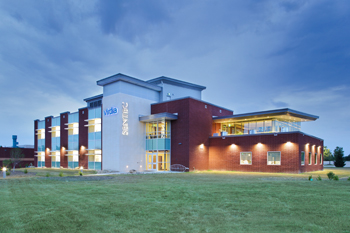Green Technology Center Models Sustainable Design
 DANVILLE, Va. — The Institute for Advanced Learning and Research in Danville, Va., recently received LEED Gold certification for its new Sustainable Energy Technology Center (SENTEC). The institute is an independent organization that works with Virginia Tech, Averett University and Danville Community College.
DANVILLE, Va. — The Institute for Advanced Learning and Research in Danville, Va., recently received LEED Gold certification for its new Sustainable Energy Technology Center (SENTEC). The institute is an independent organization that works with Virginia Tech, Averett University and Danville Community College.
The 26,000-square-foot structure, which opened in May 2012, was built to support cutting-edge industry research in biofuels. Dewberry, a Fairfax, Va.-based architectural firm, designed the facility with lab planning assistance from Perigon Engineering, located in Matthews, N.C., and sustainability consulting from Lord, Aeck & Sargent, based in Chapel Hill, N.C. New Atlantic Contracting, Inc., out of Winston-Salem, N.C., served as the general contractor on the project.
The facility takes multiple steps to change rainwater from a destructive force that flows off the roof and leads to erosion into a resource that enhances habitat instead. A green roof reduces stormwater runoff, and a 14,000-gallon rainwater collection system stores the remaining water in a large cistern before it’s used to irrigate the landscaping in front of the building. Both the green roof itself and the native landscaping provide habitat. High-efficiency plumbing fixtures and a water-saving system for the inside of the structure fill out the water-use strategy.
The design uses sunlight in multiple ways. It harvests the sun’s rays from photovoltaic cells, providing energy for the facility, and also through its windows, with sensors that adjust the brightness of artificial lighting based on the amount of available daylight. A separate set of solar thermal panels is also used to provide hot water. External sunshades and light sleeves also control heat gain and glare.
One of the interior walls was constructed with bricks salvaged from a former Dan River Mills textile plant, adding a local historical flavor. The spirit of recycling continued throughout the project, as 75 percent of the construction waste was diverted away from landfills.
SENTEC features research laboratories, faculty offices and space for graduate students to conduct their research projects. The $10.5 million project was funded by the Virginia Tobacco Indemnification Commission and Community Revitalization Commission. The organization receives funds from the Tobacco Master Settlement Agreement, which combined lawsuits against the tobacco industry from 46 states into one agreement.
The historic settlement resulted in tobacco companies paying hundreds of billions of dollars to the states. In Virginia, some of this funding is distributed by the commission to communities that were particularly reliant upon the tobacco industry to feed their local economy in an attempt to limit the economic impact of the settlement.
The city of Danville contributed some of the funding for the 13.7 kilowatt solar array, and partnered with the American Public Power Association, a Washington-based service organization supporting community-owned utilities, to fund the installation of LED lighting in the building’s public areas. The building will feature both LED and traditional lighting in various rooms so that comparisons can be made between them over time.
“We are working hard to change the culture of the region and to show people what is driving energy costs, as well as technology that can be implemented to save costs,” said Dr. Julie Brown, director of academic and outreach programs at the institute, in a press release.
